Skull found in China may belong to a 'Dragon Man' that lived one million years ... trends now
A mysterious ancient human-like skull found in China may have been the love child of two species, according to researchers.
They believe the 900,000-year-old individual was a hybrid - part us, Homo sapien, and part Homo longi, a long-lost species known as the 'Dragon Man'.
The skull baffled archaeologists when 'the Yunxian Man', named after the Yunyang District of Hubei province where it was discovered in 2022, due to its strange shape and features.
The new study recreated a full 3D model of the skull, revealing it had facial bones of a human but a flattened cranium, boxed eyes and thicker brow bone of Homo longi.
It concluded, based on the preliminary findings, that the person dubbed 'the Yunxian Man', after lineage our 'long-lost sister lineage.'

This partial skull fossil, which was damaged with age, was reconstructed to its full glory using 3D models. It led researchers to believe this could be one of the last common ancestors between Dragon men and humans.

The Dragon men, scientifically named Homo longi, had a thick upper brow bone, and big, boxy eye sockets. An illustrator depicted that likeliness here.
'It is reasonable to conclude that Yunxian is morphologically and chronologically close to the last common ancestor of the lineages of H. sapiens and Dragon Man,' the authors wrote in the study published as a pre-print on the research site BioRxiv.
The skull was one of three found in China over the past 50 years that have baffled scientists about their origins.
It might seem like simple science to determine what bone fits to what species, but scientists have yet to agree just how many human-like species there were in our recent archeological history, Anna Goldfield an archaeologist at Boston University, wrote for Sapiens.org.
Read More
Hybrid Neanderthal love child is found in a cave in Siberia: Teenage daughter of a Neanderthal mother and a Denisovan father who lived 50,000 years ago reveals how humans' ape-like cousins frequently interbred

It's widely accepted that there were two archaic human species - Neanderthals and Denisovans - which roamed the Earth as distinct groups until about 30,000 years ago - and had distinct features.
But the Yuxian man skull was difficult to put into a single category.
Based on its physical characteristics and location, researchers had thought it could be a member of the Denisovan family that originated in Asia about 500,000 years ago.
While Denisovan also had a flattened skull, it was also elongated with a protruding jaw - features not observed.
However, researchers have speculated that the 'Dragon Man' lineage could include Denisovans since the groups lived on Earth around the same time.
After analyzing the new skull, the researchers determined its traits were similar to those found in early humans and Dragon Men, meaning that it was likely an offspring of both.
The Homo longi had large, blocky eye sockets, molars that are much larger than ours, a thick brow bone and a similar brain size to



